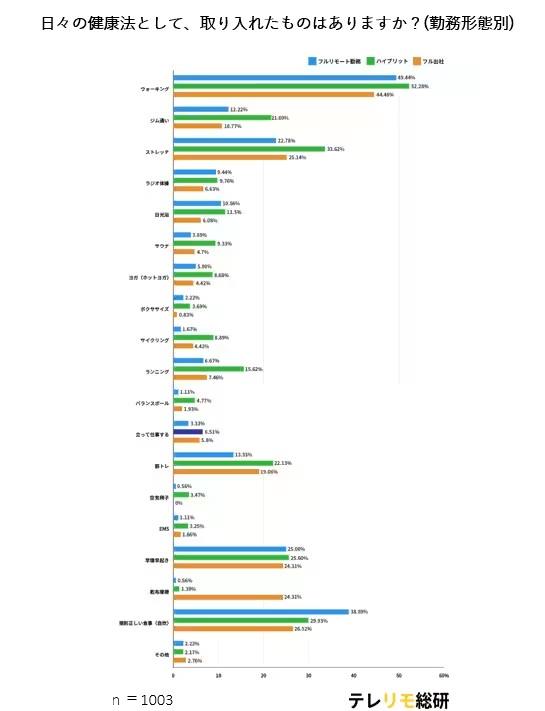

Exploring Health-Conscious Habits Among Remote Workers and the Impact of Work Styles
The Connection Between Remote Work and Health Awareness
As the trend of remote and hybrid work continues to grow, many are questioning its implications on health and lifestyle. A recent study conducted by LASSIC, a company advocating for flexible working conditions through their platform ‘Telework/Remote Work Comprehensive Research Institute,’ reveals insightful findings about the health habits of remote workers.
In recent years, remote work has gained popularity, leading to changes in daily routines and health practices. While many associate remote work with a decrease in physical activity and disrupted daily rhythms, the actual picture is more nuanced. Some individuals adapt by joining gyms or incorporating walking into their daily routines, thus navigating their health more consciously.
On the other hand, traditional office workers have the benefit of movement throughout their day but may struggle to balance exercise with their schedules. As such, contemporary work styles are shaping individual approaches to fitness and well-being in unique ways.
Key Findings on Exercise and Health Habits
In an effort to explore how work styles—remote, hybrid, and in-office—affect health habits, participants were surveyed about their daily wellness practices. Interestingly, practices such as walking, stretching, maintaining regular eating habits through self-cooking, and prioritizing a consistent sleep schedule emerged as popular habits across all types of employment.
1. Simple Exercises are Key
Many busy professionals appreciated the importance of easily manageable exercises. Rather than dedicating time to specialized training or workout attire, integrating movement into daily life seems to take precedence. The desire to make exercise a natural part of life, rather than a chore with added demands, appeared prominently in the results.
2. Variance in Gender Preferences
When analyzing the data by gender, some noticeable differences were observed. For instance, among fully remote workers, males did not show a significant concentration on any specific practice, whereas females reported a higher rate of maintaining consistent meal preparation at home. This suggests that women may place a greater emphasis on creating boundaries between work and personal life, using cooking as a means to distinguish between the two.
In the case of hybrid workers, males tended to engage in various physical activities, including gym visits and bodybuilding. Their frequent movement between home and the office appears to foster opportunities for physical activity. For females in the hybrid category, a trend towards low-intensity exercises such as stretching and yoga has been noted, possibly indicating a focus on relaxation and mental health, influenced by their work environments.
3. Full In-Office Workers Seek Convenience
When comparing those who work fully in-office, it appears that they opt for more convenient forms of exercise. Males tend to select robust practices but have lower rates of consistent habits compared to their hybrid counterparts. On the flip side, females prioritize simpler activities like early rising and cycling, which can be seamlessly integrated into their daily lives despite time constraints posed by commuting.
Unique Health Practices and Insights
Some responses from participants included unique practices, such as jumping rope twice a week or trying Pilates. Interestingly, one response mentioned “cat therapy,” showcasing the diverse ways people connect health and well-being to everyday practices.
Supporting Healthful Lifestyles in Varied Work Environments
While the volume of exercise varies by employment style, how individuals approach exercise is distinct across work environments. Remote workers often embed exercise routines into their daily lives more naturally. Notably, hybrid male workers exhibited a greater commitment to diverse health practices, actively balancing their work and personal lives for effective fitness habits.
On the other hand, those in full-time office roles might struggle, with their exercise habits more inclined towards simplicity due to time constraints. The trend shows that men often focus on strength and stamina, while women lean towards nurturing practices that promote balance and reduce stress.
Overall, this study sheds light on how various working conditions impact health habits, which could significantly inform strategies for healthier living. LASSIC intends to continue researching and revealing insights into how diverse work arrangements affect health and lifestyle choices.
For more detailed results and analysis, the findings are further elaborated on the Telework Research Institute’s website.
Survey Details
- - Survey Period: April 8, 2025 - April 16, 2025
- - Participants: 1003 working adults aged 20-65 with remote work experience
- - Method: Online survey
By recognizing the unique sets of health habits shaped by the working environment, this study aims to help individuals embrace healthier lifestyles that synchronized with their professional demands.




Topics Health)










【About Using Articles】
You can freely use the title and article content by linking to the page where the article is posted.
※ Images cannot be used.
【About Links】
Links are free to use.